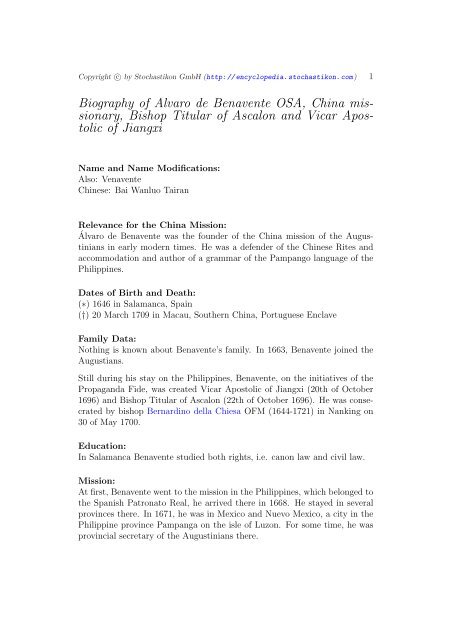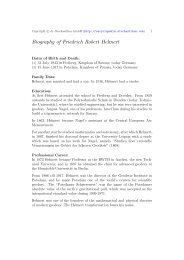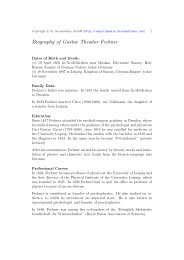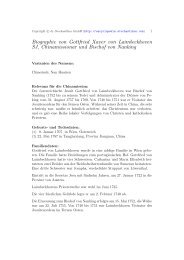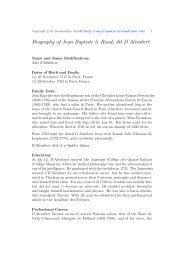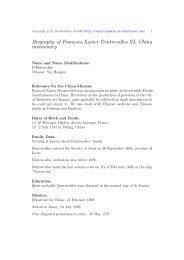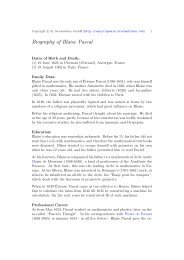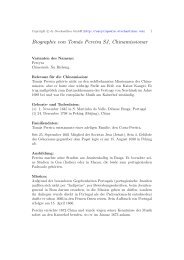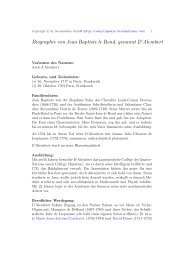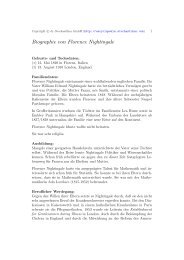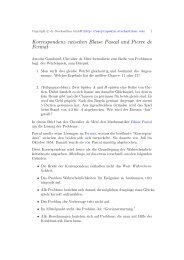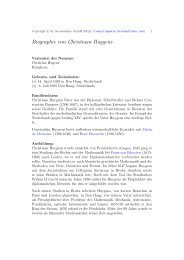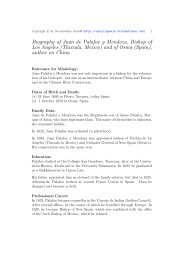Biography of Alvaro de Benavente OSA, China mis- sionary, Bishop ...
Biography of Alvaro de Benavente OSA, China mis- sionary, Bishop ...
Biography of Alvaro de Benavente OSA, China mis- sionary, Bishop ...
You also want an ePaper? Increase the reach of your titles
YUMPU automatically turns print PDFs into web optimized ePapers that Google loves.
Copyright c○ by Stochastikon GmbH (http://encyclopedia.stochastikon.com) 1<br />
<strong>Biography</strong> <strong>of</strong> <strong>Alvaro</strong> <strong>de</strong> <strong>Benavente</strong> <strong>OSA</strong>, <strong>China</strong> <strong>mis</strong><strong>sionary</strong>,<br />
<strong>Bishop</strong> Titular <strong>of</strong> Ascalon and Vicar Apostolic<br />
<strong>of</strong> Jiangxi<br />
Name and Name Modifications:<br />
Also: Venavente<br />
Chinese: Bai Wanluo Tairan<br />
Relevance for the <strong>China</strong> Mission:<br />
Álvaro <strong>de</strong> <strong>Benavente</strong> was the foun<strong>de</strong>r <strong>of</strong> the <strong>China</strong> <strong>mis</strong>sion <strong>of</strong> the Augustinians<br />
in early mo<strong>de</strong>rn times. He was a <strong>de</strong>fen<strong>de</strong>r <strong>of</strong> the Chinese Rites and<br />
accommodation and author <strong>of</strong> a grammar <strong>of</strong> the Pampango language <strong>of</strong> the<br />
Philippines.<br />
Dates <strong>of</strong> Birth and Death:<br />
(∗) 1646 in Salamanca, Spain<br />
(†) 20 March 1709 in Macau, Southern <strong>China</strong>, Portuguese Enclave<br />
Family Data:<br />
Nothing is known about <strong>Benavente</strong>’s family. In 1663, <strong>Benavente</strong> joined the<br />
Augustians.<br />
Still during his stay on the Philippines, <strong>Benavente</strong>, on the initiatives <strong>of</strong> the<br />
Propaganda Fi<strong>de</strong>, was created Vicar Apostolic <strong>of</strong> Jiangxi (20th <strong>of</strong> October<br />
1696) and <strong>Bishop</strong> Titular <strong>of</strong> Ascalon (22th <strong>of</strong> October 1696). He was consecrated<br />
by bishop Bernardino <strong>de</strong>lla Chiesa OFM (1644-1721) in Nanking on<br />
30 <strong>of</strong> May 1700.<br />
Education:<br />
In Salamanca <strong>Benavente</strong> studied both rights, i.e. canon law and civil law.<br />
Mission:<br />
At first, <strong>Benavente</strong> went to the <strong>mis</strong>sion in the Philippines, which belonged to<br />
the Spanish Patronato Real, he arrived there in 1668. He stayed in several<br />
provinces there. In 1671, he was in Mexico and Nuevo Mexico, a city in the<br />
Philippine province Pampanga on the isle <strong>of</strong> Luzon. For some time, he was<br />
provincial secretary <strong>of</strong> the Augustinians there.
Copyright c○ by Stochastikon GmbH (http://encyclopedia.stochastikon.com) 2<br />
Pr<strong>of</strong>essional Career:<br />
In 1680, <strong>Benavente</strong> arrived together with his confrere Nicolás <strong>de</strong> Ribera<br />
(1642-1711) in <strong>China</strong> and became the foun<strong>de</strong>r <strong>of</strong> the <strong>China</strong> <strong>mis</strong>sion <strong>of</strong> the<br />
Augustians. In the same year he was sent as Procurator <strong>of</strong> the Augustinians<br />
on the Philippines to Rome and Madrid on behalf <strong>of</strong> the Chinese Rites. He<br />
returned to the Philippines, where he stayed from 1690 till 1699, in 1695<br />
he was ma<strong>de</strong> provincial. Still during his stay on the Philippines <strong>Benavente</strong><br />
was appointed <strong>Bishop</strong> Titular <strong>of</strong> Ascalon by the Propaganda Fi<strong>de</strong> on 20th<br />
<strong>of</strong> October 1696, an on 22nd <strong>of</strong> October 1696 Vicar Apostolic <strong>of</strong> the Chinese<br />
province Jiangxi.<br />
<strong>Benavente</strong> arrived in <strong>China</strong> on January 1, 1700. He worked then for several<br />
years in Nanchang in the province <strong>of</strong> Jiangxi/<strong>China</strong>. Like most Augustians,<br />
also <strong>Benavente</strong> was an adherent <strong>of</strong> the method <strong>of</strong> accommodation <strong>of</strong> the Jesuits<br />
and therefore stood on their si<strong>de</strong> in the Rites Controversy. Especially he<br />
did not like that Charles Maigrot MEP (1652-1730) alone had started again<br />
the controversy with his Mandate <strong>of</strong> 1693, without consulting the other bishops<br />
and Vicars Apostolic in <strong>China</strong>. Maigrot had a.o. forbid<strong>de</strong>n all Chinese<br />
names for God without Tianzhu and he forba<strong>de</strong> that the Chinese Christians<br />
took part at the Rites for the ancestors and for Confucius. Therefore there<br />
was a meeting <strong>of</strong> the three Vicars Apostolic in April or May 1700: <strong>Benavente</strong>,<br />
Artus <strong>de</strong> Lionne MEP (1655-1713), Vicar Apostolic <strong>of</strong> Sichuan, and Basilio<br />
Brollo da Gemona OFM (1648-1704), Vicar Apostolic <strong>of</strong> Shaanxi. They met<br />
in Nanjing where <strong>Benavente</strong> stayed because he was consecrated there as a<br />
bishop, and they ma<strong>de</strong> spoke about how to <strong>de</strong>al with the question <strong>of</strong> the<br />
Rites. De Lionne, an adversary <strong>of</strong> accommodation and <strong>of</strong> the Rites, submitted<br />
a scripture <strong>of</strong> 92 propositions to his colleagues, which contained his objections<br />
against the Chinese religion and teachings. He wanted his colleagues<br />
to join him with their signature. Basilio Brollo approved all propositions<br />
besi<strong>de</strong>s one, whereas <strong>Benavente</strong> wanted to have half a year for consi<strong>de</strong>ration.<br />
On 28 October 1700 he said that the did no approve the propositions nor<br />
<strong>de</strong> Lionne’s attitu<strong>de</strong>. In June 1701 <strong>de</strong> Lionne and <strong>Benavente</strong> met again in<br />
Nanxiongfu/Guangdong, but came to no common conclusion.<br />
When the papal legate Charles-Thomas Maillard <strong>de</strong> Tournon (1668-1710)<br />
arrived in Canton in April 1705, <strong>Benavente</strong> as one <strong>of</strong> the Vicars Apostolic<br />
was invited by him to live with him in the house <strong>of</strong> the Augustinians there.<br />
After some days, <strong>Benavente</strong> gave his treatise on the Rites to Tournon, namely<br />
his “Analecta argumentorum...” (s. below), which was refuted by Tournon.<br />
But the emperor Kangxi, who received Tournon in three audiences, could not
Copyright c○ by Stochastikon GmbH (http://encyclopedia.stochastikon.com) 3<br />
bear Tournon’s refutation <strong>of</strong> Confucianism and the <strong>de</strong>mand that all Chinese<br />
Christians and also the European <strong>mis</strong>sionaries had to be more obedient to<br />
a foreign power than to him. Therefore he <strong>de</strong>man<strong>de</strong>d from all <strong>mis</strong>sionaries,<br />
who wanted to stay in <strong>China</strong>, an <strong>of</strong>ficial per<strong>mis</strong>sion to stay, the so-called<br />
piao. They had to sign that they would follow Matteo Ricci’s (1552-1610)<br />
method <strong>of</strong> accommodation, otherwise, they were expelled.<br />
When Tournon published the contents <strong>of</strong> the Roman Decree <strong>of</strong> 1704 (“Cum<br />
Deus optimus”) with his “Mandate <strong>of</strong> Nanking”, dated February 7, 1707, he<br />
even stressed the prohibitions. Therefore <strong>Benavente</strong>, who saw the dangers<br />
for the <strong>mis</strong>sion, as canonist felt obliged to make an appellation to the Holy<br />
See against it (13 April 1707); it was signed by 24 <strong>China</strong> <strong>mis</strong>sionaries and<br />
João <strong>de</strong> Cazal, the bishop <strong>of</strong> Macau. <strong>Benavente</strong>’s “Appellatio” was refuted<br />
by Clement XI. on August 8, 1709, shortly after <strong>Benavente</strong>’s <strong>de</strong>ath. In 1707<br />
<strong>Benavente</strong> went to the hospital <strong>of</strong> the Franciscans in Canton because <strong>of</strong> his<br />
Asthma, in 1708 he got the per<strong>mis</strong>sion to go to Macau, but was forbid<strong>de</strong>n<br />
to have contact there with Tournon, who stood un<strong>de</strong>r house arrest, and he<br />
should try to leave Macau as fast as possible. On September 3, 1708 <strong>Benavente</strong><br />
should travel to Peking to obtain the piao, but it was impossible for<br />
him because he was so ill, and we wanted to stay in Canton. But by imperial<br />
or<strong>de</strong>r he was expelled because he was without a piao (on 27 November<br />
1708); he went to the Ilha Ver<strong>de</strong> in Macau to the Jesuits, where he died on<br />
March 20, 1709. At first <strong>Benavente</strong> was buried in the St. Augustine Church<br />
in Macau. When in 1895 the province chapter <strong>of</strong> the Augustinians moved to<br />
Manila, his relics were buried in the St. Paul’s Church in Manila.<br />
<strong>Benavente</strong> became also important by his research on linguistics. During his<br />
time in the province Pampanga on the Philippines he completed a grammar<br />
<strong>of</strong> the Pampango language there; this grammar was kept for a long time as<br />
manuscript in the Convent <strong>of</strong> the Augustians <strong>of</strong> the Philippine Province in<br />
Valladolid. The real name <strong>of</strong> this language is Kampagan; it is one <strong>of</strong> the<br />
eight main languages on the Philippines. <strong>Benavente</strong>’s grammar followed the<br />
rules <strong>of</strong> the grammar <strong>of</strong> the Spanish Cistercian Juan Caramuel y Lobkowitz:<br />
Grammatica Audax (1651; Frankfurt 1654; Barañáin 2000). This grammar<br />
was only published recently: Edilberto Santos (ed.), Fray <strong>Alvaro</strong> <strong>de</strong> <strong>Benavente</strong>’s<br />
Arte <strong>de</strong> Lengua Pampanga (Angeles City, Philippines 2007).
Copyright c○ by Stochastikon GmbH (http://encyclopedia.stochastikon.com) 4<br />
Publications Álvaro <strong>de</strong> <strong>Benavente</strong>:<br />
• Tongxing waiqin sidai zhitu (About XXXX die Ehehin<strong>de</strong>rnisse <strong>de</strong>r Verwandtschaftsgra<strong>de</strong>),<br />
ca. (1700), s.a.: “Scriptum ejus<strong>de</strong>m Domini Ascalonensis<br />
super impedimento disparitatis cultus”, and: “Appendix ejus<strong>de</strong>m<br />
Domini Ascalonensis ad scriptum super impedimento disparitatis<br />
cultus”, Lisboa, Ajuda, Jesuitas-na-Asia 49-VI-625, ff. 451r-493r (manuscript).<br />
• Isacio Rodríguez (ed.), “<strong>Alvaro</strong> <strong>de</strong> <strong>Benavente</strong>, <strong>OSA</strong> y su ’Relacion <strong>de</strong><br />
las <strong>mis</strong>iones agustianas <strong>de</strong> <strong>China</strong>’ (1680-1686)”, Estudio Augustiniano<br />
12 (1977) pp. 731-790.<br />
• “Responsiones eius<strong>de</strong>m Illustrissimi Domini Ascalonensis ad 92. Propositiones<br />
Illustris. & Reuerendiss. Domini <strong>de</strong> Lionne Episcopi Rosaliensis”,<br />
in: François No˝el, Caspar Castner (eds.), Memoriale circa veritatem,<br />
& substantiam Facti..., Summarivm (Romae 1703) pp. 16-20.<br />
• “Actus appellationis Illustrissimi et Reverendissimi Domini Fr. Alvari<br />
<strong>de</strong> Venavente (sic), Episcopi Ascalonensis, Vicarii Apostolici in<br />
Regno Sinarum, die 13 Aprilis 1707”, in: Acta Causae Rituum... (Romae<br />
1710), L’Etat présent <strong>de</strong> l’Eglise <strong>de</strong> la Chine (1710) pp. 121-140,<br />
Memorie storiche, vol. II, (1761) pp. 148-151, German: Georg Pray,<br />
Geschichte <strong>de</strong>r Streitigkeiten..., vol. II (1791) pp. 457-473.<br />
• “Particvla Epistolae P. Aluari Benauente ex Ordine S. Augustini... Ex<br />
Vrbe Hanganfu 27 Nouembris 1700”, in: Réponse aux nouveaux ecrits<br />
<strong>de</strong>s Missions Etrangers (1702) pp. 18-38.<br />
• “Lettera di Mgr. (Alvares <strong>de</strong>) <strong>Benavente</strong> O.F.M. (sic!) vescovo d’Ascalon...,<br />
27 Febbrajo 1703”, in: Memorie storiche, vol. II(1761) pp. 204-206,<br />
and: Platel, Mémoires historiques, vol. VI (Lissabon 1766) pp. 126f.<br />
• “Lettre du Vicaire Apostolique <strong>de</strong> Kiansi au Roi d’Espagne, Canton,<br />
7. XII. 1707”, in: La Verità e l’Innocenza... (1710) p. 115.<br />
• “Litterae Vicarii Apostolic <strong>de</strong> Kiansi ad P. Franciscum Gerbillon, 2<br />
Januarii 1707”, in: La Verità e l’Innocenza... (1710) p. 116.<br />
• Edilberto Santos (ed.), Fray <strong>Alvaro</strong> <strong>de</strong> <strong>Benavente</strong>’s Arte <strong>de</strong> Lengua<br />
Pampanga (Angeles City, Philippines 2007).
Copyright c○ by Stochastikon GmbH (http://encyclopedia.stochastikon.com) 5<br />
• “Analecta argumentorum pro sententia Missionariorum Societatis Jesu<br />
circa puncta in Ritibus Sinicis conteroversa 1705”, 15. Dezember 1705,<br />
Biblioteca Nazionale Centrale Vittorio Emanuele, FG 1251/5, 40ff, subtitle:<br />
“Scriptum Illustrissimi Domini Alvari <strong>de</strong> <strong>Benavente</strong> Episcopi<br />
Ascalonensis, Vicarii Apostolici Provinciae Kiangsi, in quo <strong>de</strong>fendit<br />
usum litterarum TIEN, et XAM TI, cultum Confucii et progenitorum:<br />
An Chineses Deum vivum, et verum sub litteris, seu characteribus, cujus<br />
vox est Tien, et quorum voces Xam Ti, aliquando coluerint”, Lisboa,<br />
Ajuda, Jesuitas-na-Asia 49-VI-6, ff. 325r-450v (S.a. Kilian Stumpf’s<br />
manuscript with a quite similar title in: Rome, BNC. VE, FG 1251/5;<br />
cf. 1257/27).<br />
Álvaro <strong>de</strong> <strong>Benavente</strong> Bibliography:<br />
• Robert Streit, Bibliotheca Missionum, vol. V (Freiburg 1929) p. 979.<br />
• Robert Streit, Bibliotheca Missionum, vol. VII (Freiburg 1932).<br />
• Jesús Alvarez Fernán<strong>de</strong>z, “Fr. <strong>Alvaro</strong> <strong>de</strong> <strong>Benavente</strong>, Agustino, en los<br />
docuementos <strong>de</strong>l Archivio Romano <strong>de</strong> la Compania <strong>de</strong> Jesús (ARSJ”), in: Isacio<br />
Rodríguez Rodríguez (ed.), Agustinos en América y Filippinas. Acta <strong>de</strong>l<br />
Congreso Internacional, Valladolid 16-21 <strong>de</strong> abril <strong>de</strong> 1990 (Valldolid 1990)<br />
pp. 1035-1050.<br />
• Manuel Ares, “Las Misiones Agustinianas en <strong>China</strong> (1575-1818)”, Archivo<br />
Agustiniano 51 (1957) pp. 145-161; pp. 345-367; 52 (1958) pp. 57-76.<br />
• Agustín María <strong>de</strong> Castro, Misioneros Agustinos en el Extremo Oriente<br />
1565-1780 (= Osorio Venerable), ed. Manuel Merino (1954) pp. 41-43.<br />
• Claudia von Collani, “Tianxue benyi - Joachim Bouvets Forschungen zum<br />
Monotheismus in <strong>China</strong>”, <strong>China</strong> Mission Studies (1550-1800) Bulletin 10<br />
(1988) pp. 18-21.<br />
• Claudia von Collani, “Claudio Filippo Grimaldi zur Ankunft <strong>de</strong>s päpstlichen<br />
Legaten Charles-Thomas Maillard <strong>de</strong> Tournon in <strong>China</strong>”, Monumenta Serica<br />
42 (1994) pp. 341f, 354-357.<br />
• Claudia von Collani, “Artus <strong>de</strong> Lionne et la Chine”, in: Actes du VIIe<br />
Colloque international <strong>de</strong> Sinologie, Chantilly 1992 (Paris - Taipei 1995) pp.<br />
45-79.<br />
• Claudia von Collani, “Kilian Stumpf SJ zur Lage <strong>de</strong>r <strong>China</strong><strong>mis</strong>sion im<br />
Jahre 1708”, Neue Zeitschrift für Missionswissenschaft 51 (1995) pp. 180f.<br />
• Claudia von Collani, “Mission and Matrimony”, in: Ku Wei-ying (ed.),<br />
Mis<strong>sionary</strong> Approaches and Linguistics in Mainland <strong>China</strong> and Taiwan (Leuven<br />
Chinese Studies X) (Leuven 2001) pp. 11-31.<br />
• Claudia von Collani, “Augustinians”, in: Nicolas Standaert (ed.), Hand-
Copyright c○ by Stochastikon GmbH (http://encyclopedia.stochastikon.com) 6<br />
book <strong>of</strong> Oriental Studies, section four: <strong>China</strong>, vol. XV/1 (Lei<strong>de</strong>n, Boston,<br />
Köln 2001) pp. 339-343.<br />
• Claudia von Collani, “Der Ritenstreit und die Folgen für die <strong>China</strong><strong>mis</strong>sion”,<br />
Zeitschrift für Missionswissenschaft und Religionswissenschaft 90 (2006) pp.<br />
210-225.<br />
• Otto Maas, Cartas <strong>de</strong> <strong>China</strong> II, (Sevilla 1917) pp. 185-190.<br />
• Georges Mensaert, “L’établissement <strong>de</strong> la Hierarchie catholique en Chine<br />
<strong>de</strong> 1684 à 1721”, Archivum Francicanum Historicum 46 (1953) pp. 369-416.<br />
• Manuel Merino, Agustinos Evangelizadores <strong>de</strong> Filipinas 1565-1965 (1965)<br />
p. 122.<br />
• Manuel Merino, “Origenes <strong>de</strong> las Misiones Augustianas en Chine”, Missionalia<br />
Hispanica XXXVII (1980) 57-110.<br />
• Joseph Metzler, “<strong>Alvaro</strong> <strong>de</strong> <strong>Benavente</strong> <strong>OSA</strong> en los documentos <strong>de</strong>l Archivo<br />
Secreto Vaticano”, in: Isacio Rodríguez Rodríguez (ed.), Agustinos en América<br />
y Filippinas. Acta <strong>de</strong>l Congreso Internacional, Valladolid 16-21 <strong>de</strong> abril <strong>de</strong><br />
1990 (Valldolid 1990) pp. 827-859.<br />
• Emilio Ridruejo, “El Arte <strong>de</strong> Lengua Pampanga (1699) <strong>de</strong> Fray Álvaro <strong>de</strong><br />
<strong>Benavente</strong>”, in: Milka Villayandre Llamazares (ed.), Actas <strong>de</strong>l V Congreso<br />
<strong>de</strong> Lingüística general, Léon, 5-6 <strong>de</strong> marzo <strong>de</strong> 2002, vol. III (Madrid 2004)<br />
pp. 2331-2343.<br />
• Isacio Rodríguez Rodríguez, “Bibliografia”, Historia <strong>de</strong> la Provincia Agustiniana<br />
<strong>de</strong>l Smo. nombre <strong>de</strong> Jesús <strong>de</strong> Filipinas I (1965).<br />
• Juan Ruiz <strong>de</strong> Medina, “Los orígenes <strong>de</strong> las <strong>mis</strong>iones Agustinianas en <strong>China</strong><br />
a partir <strong>de</strong> Macao”, in: Isacio Rodríguez Rodríguez (ed.), Agustinos en<br />
América y Filippinas. Acta <strong>de</strong>l Congreso Internacional, Valladolid 16-21<br />
<strong>de</strong> abril <strong>de</strong> 1990 (Valldolid 1990) pp. 861-880.<br />
• Sinica Franciscana, vol. III (1936) p. 236 Nr. 1.<br />
• Sinica Franciscana, vol. V (1954) p. 382 Nr. 8.<br />
• Nicolas Standaert (ed.), Handbook <strong>of</strong> Christianity in <strong>China</strong>. Volume One:<br />
635-1800. (Handbook <strong>of</strong> Oriental Studies, section 4: <strong>China</strong> 15/1. Handbuch<br />
<strong>de</strong>r Orientalistik, Abt. 4: <strong>China</strong> 15) (Lei<strong>de</strong>n, Boston, Köln 2001) pp. 339-<br />
343.<br />
• Manuel Teixeira, “D. Fr. Álvaro <strong>de</strong> <strong>Benavente</strong> em Macau”, Boletim ecclesiástico<br />
da Diocese <strong>de</strong> Macau 56 (1958).<br />
• Anastase Van <strong>de</strong>n Wyngaert, “Mgr Fr. Pallu et Mgr Bernardin <strong>de</strong>lla<br />
Chiesa. Le serment <strong>de</strong> fi<strong>de</strong>lité aux Vicaires Apostoliques 1680-1688”, Archivum<br />
Franciscanum Historicum 31 (1938) pp. 17-47.<br />
• Ad Dudink, Nicolas Standaert, Chinese Christian Texts Database (CCT-<br />
Database) http://www.arts.kuleuven.be/sinology/cct/cct.htm (14 May 2009).
Copyright c○ by Stochastikon GmbH (http://encyclopedia.stochastikon.com) 7<br />
Author(s) <strong>of</strong> this contribution:<br />
Claudia von Collani<br />
Version: 1.00


